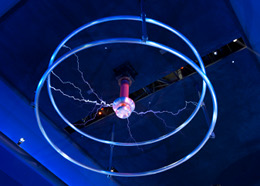The Museum of Science and Industry’s newest exhibit, “Science Storms,” will blow you away. It’s like a science class on steroids—and a perfect complement to anything your crew is learning at school.
Encompassing two stories of the museum, you’ll want to enter on the ground floor, where the sheer enormity of the exhibit impresses. My kids’ mouths dropped at the 40-foot tornado in action. It’s also interactive, allowing spectators to adjust wind flow and volume.
Here’s why I love this museum so much: The MSI understands that older kids benefit from hand-on learning just as much as the toddler set.
Kids can learn what it’s really like to be a “storm chaser” with an interactive video experience where you pick a rig, choose a storm, chase it down and deploy weather equipment.
 Another signature piece to the exhibit–the ceiling-mounted, 20-foot Tesla coil, which simulates electricity in action. Be prepared–it’s loud. Staff-led demonstrations give museum-goers a chance to learn more, and it’s a great way to work with kids who maybe have a fear of thunderstorms. Knowledge is power, right?
Another signature piece to the exhibit–the ceiling-mounted, 20-foot Tesla coil, which simulates electricity in action. Be prepared–it’s loud. Staff-led demonstrations give museum-goers a chance to learn more, and it’s a great way to work with kids who maybe have a fear of thunderstorms. Knowledge is power, right?
The second floor is home to two of the most popular parts of the exhibit, the wind tubes and a tennis ball launch. Two wind tubes allow museum-goers to stand inside and feel 80-mile-an-hour winds for a few seconds. Truthfully, it felt tamer than I expected, so don’t be afraid to let the kids try it.
The tennis ball launch is a brilliant take on physics, teaching kids about parabolas, velocity, angles and projectiles. It was my kids’ favorite, as Derrick Rose from the Chicago Bulls shows kids how to launch a tennis ball across the balcony to the other side, allowing them to select the speed and angle. (Hint: There are two stations opposite each other, with one directly at the top of the escalator. If there’s a wait, head to the other side, where fewer people may be waiting.)
 Also up on the second floor of the exhibit is an engaging “fire versus water” display, where participants can actively control a fire’s flame and water spray to see how the two elements interact.
Also up on the second floor of the exhibit is an engaging “fire versus water” display, where participants can actively control a fire’s flame and water spray to see how the two elements interact.
As part of a lesson about light and color, a large, walk-in light box allows people to control the amounts of red, blue and green lighting to create stunning displays–My guess is this would be phenomenal therapy for Seasonal Affective Disorder sufferers!
Natural disasters such as tsunamis and avalanches are broken down into easy-to-understand pieces, and are great for reinforcing physics lessons–something this writer never understood in high school.
It’s new and exciting, so of course it’s busy–but somehow, MSI never seems to feel overly crowded. Despite the sea of people we witnessed coming into the  museum (Hint: Get/Renew your membership online and literally skip to the front of the line!), there was very little of a wait to experience the interactive parts of the exhibit. Plan on spending about two hours to really enjoy the exhibit.
museum (Hint: Get/Renew your membership online and literally skip to the front of the line!), there was very little of a wait to experience the interactive parts of the exhibit. Plan on spending about two hours to really enjoy the exhibit.
Make a day of it: MSI members get free admission to an IMAX movie, so take advantage of it and see “Hubble.” Even non-science geeks will be blown away by the imagery. I left the movie feeling very small and insignificant–in a good way!

